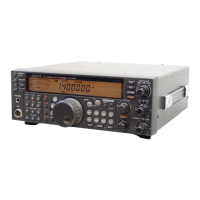
Do you have a question about the Kenwood TS-570D, TS-570S and is the answer not in the manual?
| Power Output (SSB, CW, FM) | 100 W |
|---|---|
| Voltage | 13.8 VDC |
| Current Drain RX | 1.5 A |
| Memories | 100 |
| Type | HF Transceiver |
| Frequency Range RX | 0.5-30 MHz |
| Mode | SSB, CW, AM, FM |
| Receiver Sensitivity (FM) | 0.5 μV (12 dB SINAD) |
| Selectivity (CW) | 500 Hz (-6 dB) |
| Selectivity (AM) | 6 kHz (-6 dB) |
| Selectivity (FM) | 30 kHz (-60 dB) |
| Impedance | 50 Ω |
Details included accessories like microphone, cables, fuses, and manuals.
Provides FCC warnings and guidelines for digital device users to avoid interference.
Covers electrical safety, grounding, ventilation, water, heat, cleaning, and servicing.
Explains antenna connection and approximated coaxial cable loss.
Guides on DC power supply connection and lightning protection.
Instructions for replacing fuses and troubleshooting blown fuses.
Details connections for front panel (headphones, mic) and rear panel (speaker, key).
Guides through initial receiving setup and tuning.
Covers basic transmitting steps and antenna tuner usage.
Introduces the front panel layout and details key buttons and controls.
Details the functions of various front panel buttons and controls.
Explains buttons for frequency selection and memory operations.
Describes controls for audio, gain, DSP, IF shift, and squelch.
Explains the microphone and the versatile MULTI/CH control.
Explains meter functions and indicators for operating modes.
Details indicators for functions like SPLIT, RIT, NB, and BEAT CANCEL.
Explains indicators for frequency display, VFO/Memory selection, and mode status.
Covers powering on/off, adjusting volume, and RF gain settings.
Guides on selecting VFO modes and radio bands.
Explains selecting operating modes and frequencies.
Details squelch adjustment and front panel meter functions.
Covers setting transmit power and adjusting microphone gain.
Introduces the menu system and provides instructions for accessing and using it.
Continues the table of menu items for digital operation and data transfer.
Completes the menu table and introduces a cross-reference.
Provides a subject-based index to locate menu functions.
Explains basic SSB transmission procedures and settings.
Details CW operation, auto zero-beat, and sidetone settings.
Guides on FM and AM transmission basics, frequency, and mode.
Explains split-frequency and TF-SET functions for advanced communication.
Guides on FM repeaters, subtone, and CTCSS for selective communication.
Continues CTCSS explanation for call/response scenarios.
Introduces digital modes and details RTTY operation.
Covers various digital modes and their characteristics.
Explains SSTV, FAX, and Satellite communication methods.
Details direct entry, 1MHz steps, quick changes, and fine tuning.
Explains VFO copy, RIT, AGC, and RX Equalizer functions.
Explains VOX function, delay time, and microphone input level.
Explains Speech Processor for audio quality and XIT for transmit frequency adjustment.
Guides on adjusting transmit bandwidth and audio equalization.
Covers monitoring signals, transmit inhibit, and changing frequency while transmitting.
Explains CW break-in modes and the built-in electronic keyer.
Details keyer speed adjustment and auto weighting features.
Covers keyer weighting, bug key, and CW message memory functions.
Explains IF filter, IF Shift, and Noise Blanker for interference reduction.
Introduces DSP tools and changing receive bandwidth.
Explains the Attenuator and Preamplifier functions.
Guides on filter settings and Noise Reduction functions.
Covers memory backup and the use of conventional memory channels.
Guides on storing simplex channels and data into memory.
Explains retrieving and scrolling through memory channels.
Guides on temporarily changing memory data.
Explains split-frequency operation using memory channels and VFOS.
Guides on transferring data between memory and VFOS, and between memory channels.
Guides on storing frequency ranges and using programmable VFO.
Explains how to erase memory and perform a full system reset.
Explains memory lockout and introduces Quick Memory for temporary data storage.
Guides on recalling, temporarily changing, and transferring Quick Memory data.
Explains Program Scan and the Scan Hold feature.
Explains All-channel Scan and Group Scan operations.
Covers resets, antenna switching, and frequency lock convenience features.
Explains beep function, display dimmer, and customizing function buttons.
Details equipment, connections, and performing quick data transfer.
Covers connecting a computer and setting communication parameters.
Explains using the transceiver with a transverter.
Guides on operating the internal tuner and its preset function.
Details the installation of the DRU-3A unit.
Guides on installing the VS-3 unit and IF filters.
Details the installation of the SO-2 TCXO unit.
Illustrates connections for computers and compatible transceivers.
Explains connecting RTTY, linear amplifier, and antenna tuner equipment.
Details connecting MCP and TNC devices for digital operations.
Covers general maintenance, service notes, and equipment service.
Explains reference frequency calibration and accessing internal fuses.
Lists general and transmitter technical specifications.
Lists receiver technical specifications.
Details the hardware and control operation for computer communication.
Explains the structure and types of computer control commands.
Lists alphabetical commands and their functions.
Maps menu numbers and items to parameter formats.
Details menu selection parameters for the "EX" command.
Shows command tables for specific functions like Antenna Tuner.
Continues command tables for Beat Cancel, CW Auto Zero-beat, etc.
Continues command tables for Filter Width, Keyer Speed, etc.
Continues command tables for Memory Channel, MIC Gain, etc.
Continues command tables for Power Control, RIT, etc.
Continues command tables for Scan, Squelch, and System Reset.
Continues command tables for VOX and XIT functions.
